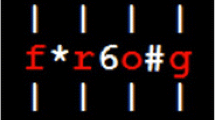Summary
The Stroop-phenomenon in its single-trial reaction-time version is analyzed in terms of Donders's additive-components approach. The complete set of component tasks forms an incomplete factorial design, and so, for resolving reaction times into their component parts multiple regression with dummy coding is used. The results of two independent experiments confirm the asymmetry of the incongruence effect in naming and reading, but contradict the redundancy hypothesis for congruent items. This finding is consistent with the linear approach which in Exp. 1 accounts for about 45%, and in Exp. 2 for about 30%, of total reaction-time variance. In a third experiment reaction times for the detection of colours/words and for congruence/incongruence are measured. These data confirm the estimation of both the basic constant and the assumed matching component in the first two experiments. Finally it is proposed that the data can be interpreted on the assumption that a matching process is responsible for the incongruence effect in naming. Reading interference does not normally occur because of faster processes or fewer stages in a parallel ‘reading’ channel. Different strategies in coping with the Strooptask (‘reading’ vs ‘inhibition’) may explain differences between Exps. 1 and 2 and the absence of the redundancy effect from the data. The constraints on such assumptions in the context of reaction-time measurement are discussed.
Similar content being viewed by others
References
Bamber, D., Herder, J., Tidd, K.: Reaction times in a task analogous to ‘same-different’ judgement. Percept. Psychophys. 18, 321–327 (1975)
Donders, F.C.: Die Schnelligkeit psychischer Processe. Arch. Anat. Physiol. 6, 657–681 (1868)
Dyer, F.N.: The Stroop phenomenon and its use in the study of perceptual, cognitive and response processes. Memory and Cognition 1, 106–120 (1973 a)
Dyer, F.N.: Same and different judgements for word-color pairs with “irrelevant” words or colors: Evidence for word-code comparisons. J. Exp. Psychol. 98, 102–108 (1973 b)
Dyer, F.N., Severance, L.J.: Effects of irrelevant colors on reading of color names: A controlled replication on the “reversed Stroop” effect. Psychon. Sci. 28, 336–338 (1972)
Egeth, H., Blecker, D.L., Kamlet, A.S.: Verbal interference in a perceptual comparison task. Percept. Psychophys. 6, 355–356 (1969)
Garner, W.R.: The stimulus in information-processing. Am. Psychologist 25, 350–358 (1970)
Glaser, W.R., Dolt, M.O.: A functional Model to localize the conflict underlying the Stroop phenomenon. Psychol. Res. 39, 287–310 (1977)
Hintzman, D.L., Carff, F.A., Eskridge, V.L., Owens, A.M., Shaff, S.S., Sparks, M.E.: “Stroop” effect: Input or output phenomenon? J. Exp. Psychol. 95, 458–459 (1972)
Hock, H.S., Egeth, H.: Verbal interference with encoding in a perceptual classification task. J. Exp. Psychol. 83, 299–303 (1970)
Jensen, A.R., Rohwer, W.D. (Jr.): The Stroop color-word test: A review. Acta Psychol. 25, 36–93 (1966)
Kerlinger, F.N., Pehadzur, E.J.: Multiple regression in behavioral research. New York: Holt, Rinehart, Winston 1973
Klein, G.S.: Semantic power measured through the interference of words with color naming. Am. J. Psychol. 77, 576–588 (1964)
Krueger, L.E.: A theory of perceptual matching. Psychol. Rev. 85, 278–304 (1978)
Mainka, G.: Theoretische und experimentelle Analysen zum Interferenzphänomen. Berlin: Dissertation, Freie Universität (1970)
Massaro, D.W.: Experimental psychology and information processing. Chicago: Rand McNally (1975)
Neill, W.T.: Inhibitory and facilitatory processes in selective attention. J. Exp. Psychol.: Human Percept. and Performance 3, 444–450 (1977)
Pachella, R.G.: The interpretation of reaction time in information-processing research. In: Human information processing: Tutorials in performance and cognition, Kantowitz, B.H. (Ed.), pp. 41–82. Potomac: Lawrence Erlbaum Assoc. 1974
Prinz, W.: Reaktionszeit-Fraktionierung durch Varianzanalyse. Arch. Psychol. 124, 240–252 (1972)
Pritchatt, D.: An investigation into some of the underlying processes of the Stroop colour effect. Quart. J. Exp. Psychol. 20, 351–359 (1968)
Schulz, Th.: Stroop-Interferenz. Theorie und Daten. Psychol. Beitr. 20, 72–114 (1978)
Searle, S.R.: Matrix algebra for the biological sciences. New York: Wiley 1966
Seymour, P.H.K.: A model for reading, naming and comparison. Br. J. Psychol. 64, 35–49 (1973)
Seymour, P.H.K.: Conceptual encoding and locus of the Stroop effect. Quart. J. Exp. Psychol. 29, 245–265 (1977)
Sichel, J.C., Chandler, K.A.: The color-word interference test: The effects of varied color-word combinations upon verbal response latency. J. Psychol. 72, 219–231 (1969)
Stroop, J.R.: Studies of interference in serial verbal reactions. J. Exp. Psychol. 18, 643–662 (1935)
Taylor, D.A.: Stage analysis of reaction time. Psychol. Bull. 83, 161–191 (1976)
Taylor, D.A.: Time course of context effects. J. Exp. Psychol.: General 106, 404–426 (1977)
Teichner, W.H., Krebs, M.: Laws of simple visual reaction time. Psychol. Rev. 79, 344–358 (1972)
Townsend, J.T.: Issues and models concerning the processing of a finite number of inputs. In: Human information processing: Tutorials in performance and cognition. Kantowitz, B.H. (Ed.), pp. 133–185. Potomac: Lawrence Erlbaum Assoc. 1974
Van der Heijden, A.H.C.: Some evidence for a limited capacity selfterminating process in simple visual search tasks. Acta Psychol. 39, 21–41 (1975)
Winer, B.J.: Statistical principles in experimental design. London, New York: McGraw Hill: Student edition 1970
Author information
Authors and Affiliations
Additional information
Parts of the data analyzed here were reported at the 18th Congress of Experimental Psychology in April 1976 at Bochum. K.P. Muthig, now at the Free University of Berlin, Dpt. 12, helped in the performance and analysis of the first and third experiments.
I gratefully acknowledge the helpful comments of O. Neumann (Bochum) and of three anonymous reviewers of an earlier version of this paper.
Rights and permissions
About this article
Cite this article
Schulz, T. Components of the reaction time stroop-task. Psychol. Res 40, 377–395 (1979). https://doi.org/10.1007/BF00309418
Received:
Issue Date:
DOI: https://doi.org/10.1007/BF00309418




